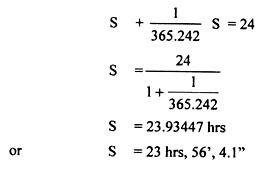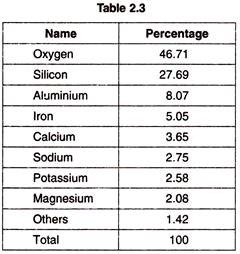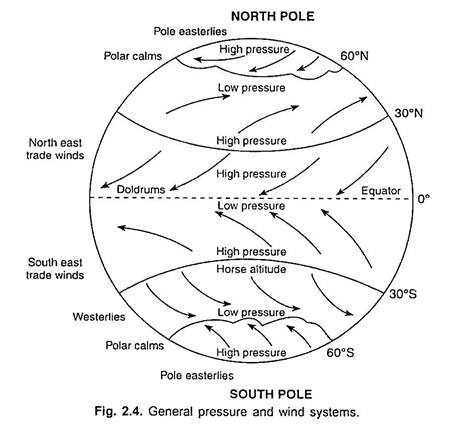ADVERTISEMENTS:
Because of the small size of the earth compared to the sun and the great distance between the two (149 million kilometres), only a minute percentage of solar radiation—one in two billion parts—is intercepted by the earth. But even this small amount of solar radiation reaching the earth is of great significance. All biological and many of the physical phenomena of the earth are controlled by this tiny proportion of solar radiation.
The incoming solar radiation is known as insolation. It is received in the form of short waves which are of electromagnetic nature. These short-wave or ultraviolet rays are absorbed partly by the atmosphere and, on reaching the earth, are converted into long-wave radiation by reflection. The earth’s surface receives this radiant energy at the rate of two calories per square centimetre per minute.
Factors Affecting Distribution of Insolation:
The amount of insolation reaching the earth’s surface and its effectiveness per unit area depends on the following factors:
1. The Angle of Incidence or the Inclination of the Sun’s Rays:
ADVERTISEMENTS:
The angle of incidence or the angle which the sun’s rays make with the earth’s surface, determines the amount of solar radiation which a particular place on the earth will receive. A smaller angle means the same amount of radiation will have to serve a larger area on the earth and the intensity will be less concentrated. A larger angle means the sun’s rays will be nearly vertical over the place and the given amount will have to serve a smaller area. As a result, the radiation received will be more concentrated and the intensity will be greater. See Fig. 2.2 (i) and
(ii) For instance, at 45° latitude, the amount of radiation received is only 75% of what is received at the equator. At Arctic/Antarctic Circles and at Poles, this figure is 50% and 40% respectively.
2. Duration of Sunshine:
The amount of solar radiation received obviously depends on the length of time that the sun shines over a particular place. At the equator, where the duration of sunshine is 12 hours daily throughout the year, the amount of radiation received is more compared to the other places on the earth. At winter solstice (22 December), the southern hemisphere receives more sunshine as it is summer there, while at summer solstice (21 June), the northern hemisphere receives more sunshine as it is summer time there. [Fig. 2.2 (iii)].
3. Transparency of Atmosphere:
The amount of cloud cover and its thickness, dust and water vapour which determine the transparency of the atmosphere affect the reflection, absorption and transmission of solar radiation. If the wavelength (X) of the radiation is more than the radius of the obstructing particle (such as a gas), then scattering of radiation takes place. If the wavelength is less than the obstructing particle (such as a dust particle), then total reflection takes place. Absorption of solar radiation takes place if the obstructing particles happen to be water vapour, ozone molecules, carbon dioxide molecules or clouds. [Fig. 2.2 (iv)].
ADVERTISEMENTS:
4. Land-Sea Differential:
The temperature of the air resting over a landmass differs markedly from that of the air resting over an expanse of water in the same latitude: (i) Reflection is more by land than by sea. Especially snow covered areas reflect upto 70%-90% of insolation, (ii) Average penetration of insolation, and therefore heat, is more in water—upto 20 metres, than in land—where it is upto 1 metre only. Therefore, land cools more rapidly, (iii) The specific heat of water is 2.5 times higher than landmass, therefore water takes longer to get heated up and to cool down, (iv) The currents, tides and drifts exist only in oceans which carry the heat to lower layers. This delays the process of heating and cooling. [Fig. 2.3 (i)].
5. Prevailing Winds:
ADVERTISEMENTS:
The oceanic winds have the capacity to take the moderating influence of the sea to coastal areas—reflected in cool summers and mild winters. This effect is pronounced only on the windward side. The leeward side or the interiors do not get the moderating effect of the sea, and therefore experience extremes of temperature. [Fig. 2.3 (ii)].
6. Aspects of Slope:
The direction of the slope and its angle control the amount of solar radiation received locally. Slopes more exposed to the sun receive more solar radiation than those away from the sun’s direct rays. In many valleys, settlements and cultivation are, therefore, concentrated on southern slopes, whereas northern slopes remain forested. In our country, this phenomenon is well observed in the Himalayan region. [Fig. 2.3 (ii)].
7. Ocean Currents:
Ocean currents influence the temperature of adjacent land areas considerably. Warm currents raise the temperatures of the coastal areas, whereas cold currents lower them. For instance, in higher latitudes, the eastern coasts have much lower temperatures than the western coasts due to the influence of cold currents. Similarly, the North Atlantic Drift, an extension of the warm Gulf Stream, keeps winter temperatures in Great Britain and much of Western Europe warmer than one would expect for their latitudes. Because of the prevailing westerly winds, the moderating effects of the ocean currents are carried far in land. (Fig. 2.4).
The influence of the old currents is most pronounced in the tropics or during the summer months in the mid-latitudes. For instance, the cold Benguela Current off the western coast of southern Africa moderates the tropical heat.
8. Altitude:
Altitude has a direct effect on prevailing temperatures. This is because the lower layers of the atmosphere are compressed under atmospheric pressure and are closer to the earth’s surface; it makes them warmer than the layers at higher levels. Thus, as we go higher, the temperature gradually decreases and the air becomes cooler. The normal lapse rate is roughly 1°C for every 165 metres of ascent.
There are variations from the normal at different times of the day, in different seasons and in different locations of places. For instance, the two cities in Ecuador-Quito and Guayaquil—although quite close to each other—have meant annual temperatures of 13.3° C and 25.5° C respectively. This is because Guayaquil is only 12 metres above sea level, while Quito is higher in the Andes Mountains at 2,800 metres.
Three Ways of Transfer of Heat Energy:
The heat energy from the solar radiation is received by the earth through three mechanisms:
1. Radiation:
ADVERTISEMENTS:
Which means transmission from one body to another? It is possible in relatively emptier space, for instance, from the sun to the earth through space. (Fig. 2.5)
2. Conduction:
Which means through matter? By molecular activity. Generally, denser materials like water are good conductors and a lighter medium like air is a bad conductor of heat. (Fig. 2.5)
3. Convection which means transfer of heat energy by actual transfer of matter or substance from one place to another.
Latitudinal Heat Balance:
In spite of the heat balance maintained by the earth, the amount of insulation received varies from latitude to latitude. It decreases from the equator towards the poles. At latitudes below 40°, more solar radiation is received than is lost to space by the earth. The opposite is true for higher latitudes where more heat is lost than received. Going by this logic, the tropics should have been getting progressively hotter and the poles getting progressively cooler.
But, in reality, this does not happen. The atmosphere and the oceans act as giant thermal engines that transfer heat from the tropics towards the poles. Due to an imbalance of heat, winds and ocean currents are produced which act as vehicles for transportation of heat energy from lower to higher latitudes.
As most of the heat transfer takes place across the mid-latitudes (30° to 50°), much of the stormy weather is associated with this region. Thus, the transfer of surplus energy from the lower latitudes to the deficit energy zone of the higher latitudes maintains an overall balance over the earth’s surface. (Fig. 2.6)
Heat Budget:
The earth receives a certain amount of insolation and gives back heat into space by terrestrial radiation. Through this give and take, or the heat budget, the earth maintains a constant temperature.
Let us assume that the total heat received at the top of the atmosphere is 100 units. Roughly, 35 units are reflected into space even before reaching the earth’s surface—27 units are reflected from the top of the clouds and 2 units from the snow and ice-covered areas of the earth while 6 units are reflected by the atmospheric layer itself. The reflected amount of radiation is called the albedo of the earth.
The remaining 65 units are absorbed, 14 units within the atmosphere and 51 units by the earth’s surface. The earth radiates back 51 units in the form of terrestrial radiation. Of these, 17 units are radiated to the space directly and the remaining 34 units are absorbed by the atmosphere. Forty-eight units absorbed by the atmosphere (14 units from insolation + 34 units from terrestrial ‘radiation) are also radiated back into space. Thus, the total radiation returning from the earth and the atmosphere respectively is 17+48=65 units which balances the total of 65 units received from the sun. This is termed as heat budget or heat balance of the earth.
The Mean Annual Temperature Distribution over Earth:
The horizontal or latitudinal distribution of temperature is shown with the help of a map with isotherms (i.e., imaginary lines joining places having equal temperatures, reduced to sea level to eliminate the effects of altitude.) Isotherms have three general characteristics:
1. Isotherms tend east-west, generally following the parallels.
2. Isotherms take sudden bends where land- water contrasts are maximum.
3. The spacing of isotherms indicates the latitudinal thermal gradient i.e. steepness or slow gradual nature of temperature change. Thus, close spacing indicates a rapid change in the temperature and wide spacing means slow change.
Isotherms have close correspondence with the latitude parallels mainly because the same amount of insolation is received by all the points located on the same latitude. But, due to differential heating of land and water, temperatures above the oceans and landmasses vary even on the same latitude.
General Isothermal Trend:
The highest temperatures occur over tropics and sub-tropics, because these areas receive the highest amount of insolation. The lowest temperatures occur in continents due to the effect of continentality. The temperature gradient is generally more widely spaced over tropics and closely spaced over middle and higher latitudes. Also, the temperature gradient is more closely spaced over the eastern margins of continents. The isotherms are irregular over the northern hemisphere due to an enhanced land-sea contrast. Because of predominance of land over water in the north, the northern hemisphere is warmer.
The thermal equator lies generally to the north of geographical equator. While passing through an area with warm ocean currents, the isotherms show a pole-ward shift. This shift is very much marked over the eastern side of the North Atlantic due to the combined effect of North Atlantic Drift and Gulf Stream coupled with the Westerlies. It is marked over the North Pacific due to the combined effect of Kuroshio Current and North Pacific Current and the Westerlies.
The belt of high temperature widens over the continents. While passing from the continents to the oceans, there is a slight distortion in isotherms which becomes more prominent in the northern hemisphere. Mountains also affect the horizontal distribution of temperature. For instance, the Rockies and the Andes stop the oceanic influence from going inwards into North and South America.
By examining the isothermal maps for January and July, the changing patterns of global temperature with reference to the apparent movement of the sun, distribution of land and water, ocean currents and prevailing winds can be studied. For most places on the earth, January and July represent the seasonal extremes of temperature and, for this reason these months are most often selected for analysis.
Seasonal Distribution of Temperature- January:
During January, it is winter in the northern hemisphere and summer in the southern hemisphere. An equatorward bend of the isotherms over the northern continents shows that the landmasses are overcooled and that polar cold winds are able to penetrate southwards, even in the interiors. The isotherms over the northern oceans show a poleward shift indicating that the oceans are warmer and are able to carry high temperatures polewards.
During January, the western margins of continents are warmer than their eastern counterparts, since the Westerlies are able to carry high temperature into the landmasses, Lowest temperatures are recorded over northern Siberia and Greenland. The high temperature belt runs in the southern hemisphere, somewhere along 30°S latitude. The thermal equator lies to the south of geographical equator (because the intertropical convergence zone or ITCZ has shifted southwards with the apparent southward movement of the sun).
The temperature gradient is close to the eastern margins of continents. For instance, along the east coast of Asia and North America, the temperature changes at the rate of 1.5°C per degree latitude, while along the western margins it changes at the rate of 0.5 C per degree latitude. The isotherms exhibit a more regular behaviour in the southern hemisphere. (Fig. 2.8) Seasonal Distribution of Temperature— July, During July, it is summer in the northern hemisphere and winter in the southern hemisphere.
The isothermal behaviour is the opposite of what it is in January. Over the northern continents, a poleward bend of the isotherms indicates that the landmasses are overheated and the hot tropical winds are able to go far into the northern interiors. The isotherms over the northern oceans show an equator-ward shift indicating that the oceans are cooler and are able to carry the moderating effect into tropical interiors. The lowest temperatures are experienced over Greenland. The highest temperature belt runs through northern Africa, west Asia, north-west India arid southeastern USA. The temperature gradient is irregular and follows a zig-zag path over the northern hemisphere. The gradient becomes regular over the southern hemisphere but shows a slight bend towards the equator at the edges of continents. Thermal equator now lies to the north of the geographical equator. (Fig. 2.9)
Adiabatic Heating and Cooling:
Adiabatic change refers to the change in temperature with pressure. On descent through atmosphere, the lower layers are compressed under atmospheric pressure. As a result, they are dry and warm. On ascent, the air expands as pressure decreases. This expansion reduces the temperature and releases the latent heat of condensation in the process.
Temperature Inversion:
Normally, as we go up in the atmosphere, the temperature decreases, but under specific conditions, a condition opposite to this occurs. Sometimes, the temperature in the lower layers of air increases instead of decreasing with elevation. This happens commonly along a sloping surface. Here, the surface radiates heat back to space rapidly and cools down at a faster rate than the upper layers. As a result the lower cold layers get condensed and become heavy.
The sloping surface underneath makes them move towards the bottom where the cold layer settles down as a zone of low temperature while the upper layers are relatively warmer. This condition, opposite to normal vertical distribution of temperature, is known as Temperature Inversion. This phenomenon is specially observed in the intermontane valleys. In other words, the vertical temperature gets inverted during temperature inversion.
Ideal Conditions for Temperature Inversion:
Temperature inversion takes place only under certain specific conditions.
These conditions are:
1. Long nights, so that the outgoing radiation is greater than the incoming radiation.
2. Clear skies, which allow unobstructed escape of radiation.
3. Calm and stable air, so that there is no vertical mixing at lower levels.
Types of Temperature Inversion:
Depending on the nature of underlying surface and reasons for the temperature contrast, there are four types of temperature inversion:
1. Air Drainage Type of Inversion:
This type of inversion occurs in a valley, where the dense, cold lower level air slides or drains down a slope to settle down at the bottom of the valley. As a result the valley floor has a lower temperature gradient than the upper layers, which are relatively warm. (Fig. 2.10)
2. Surface Temperature Inversion:
This is the most common type of temperature inversion and occurs even on relatively plain surfaces. A rapid radiation of heat occurs in places where the air is still, clear and
dry and the winter nights are long. The temperature, as a consequence, falls rapidly and temperature inversion takes place. This temperature inversion is not very deep and is destroyed as the sun rises. (Fig. 2.10)
3. Advectional type of Temperature Inversion:
There are places where many types of airmasses meet. The colder airmass, being heavy, settles down, while the warmer airmass, being light, rises over the colder airmass. This creates temperature inversion. This types of inversion is unstable and is destroyed as the weather changes. (Fig. 2.10)
4. Upper Surface Temperature Inversion:
Sometimes massive upper layers descend and press the layers below them. As a result the upper layers get warmed up and settle over the cold layers, and temperature inversion takes place. This keeps the atmosphere stable for a long time. Such a condition exists in dry atmosphere. In the winters of mid-latitudinal continental areas, stable high pressure conditions are created, as mentioned above, and create temperature inversion. This temperature inversion is called upper surface temperature inversion because it takes place in the upper parts of the atmosphere.
Economic Implications of Temperature Inversion:
Sometimes, the temperature of the air at the valley bottom reaches below freezing point, whereas the air at higher altitude remains comparatively warm. As a result, the trees along the lower slopes are bitten by frost, whereas those at higher levels are free from it. Due to inversion of temperature, air pollutants such as dust particles and smoke do not disperse in the valley bottoms.
Because of these factors, houses and farms in intermontane valleys are usually situated along the upper slopes, avoiding the cold and foggy valley bottoms. For instance, mulberry planters in Suwa basin of Japan, coffee growers of Brazil and apple growers and hoteliers of mountain states of Himalayas in India avoid lower slopes.
Vertical Distribution of Temperature:
The normal, lapse rate is uniform at a given level at all latitudes within the troposphere. At the tropopause, the lapse rate stops at zero i.e. there is no change in temperature there. In the lower stratosphere, the lapse rate remains constant for some height, while higher temperatures exist over the poles because this layer is closer to earth at the poles.
Temperature Anomaly:
The difference between the mean temperature of a place and the mean temperature of its parallel (latitude) is called the temperature anomaly or thermal anomaly. It expresses deviation from the normal. The temperature variation along a latitude varies on account of altitude, land-water contrasts, prevailing winds and ocean currents.
The largest anomalies occur in the northern hemisphere and the smallest in the southern hemisphere. The anomaly is said to be negative when the temperature at a place is less than the expected temperature of the latitude. Conversely, the anomaly is positive when the temperature at a place is more than the expected temperature of the latitude. For the year as a whole, the anomalies are negative over the continents from about 40° latitude towards the poles and positive towards the equator. Over the oceans, the anomalies are positive pole-ward from about 40° latitude and negative towards the equator.









